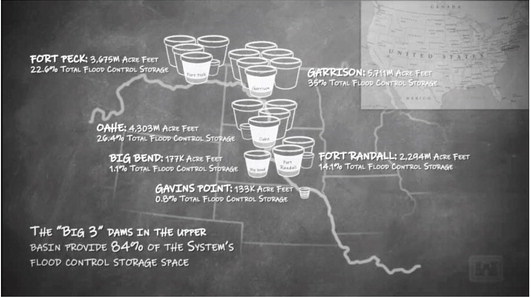Runoff Forecast Remains Above Average


Reservoir inflows in the Missouri River basin above Sioux City, Iowa (upper Basin) were well-below average in March. The updated 2021 upper Basin runoff forecast is 21.3 million acre-feet (MAF), 83 percent of average.
“Abundant precipitation fell during March in the lower Basin below Sioux City, Iowa, however, March precipitation was less than 50 percent of normal over much of the upper Basin,” said John Remus, chief of the U.S. Army Corps of Engineers’, Missouri River Basin Water Management Division. “Due to the lack of plains snowpack in 2021, below- average mountain snowpack, and dry upper Basin conditions, we expect upper Basin runoff to be below average.”
The upper Basin runoff forecast is based on soil moisture conditions, plains snowpack, mountain snowpack, and long-term precipitation and temperature outlooks. System storage is currently 56.1 MAF, at the base of the annual flood control zone. The System is positioned to serve all Congressionally authorized purposes during 2021, including flood control, navigation, and water supply.
Mountain and Plains Snowpack: Mountain snowpack in the upper Basin is accumulating at below-average rates. The April 1 mountain snowpack in the Fort Peck reach was 88 percent and the mountain snowpack in the Fort Peck to Garrison reach was 94 percent of average. By April 1, about 97 percent of the total mountain snowpack has typically accumulated. Mountain snowpack normally peaks near April 15. Currently, plains snowpack in the upper Basin is light.
Navigation: Gavins Point Dam releases were increased near the end of March to begin flow support for Missouri River navigation. The March 15 System storage indicated that flow support for Missouri River navigation would be at the full-service level for the first half of the 2021 season, in accordance with the guidelines in the Master Manual. Full-service flow support began on April 1 at the mouth of the Missouri River. Full-service flow support, in combination with the Bank Stabilization and Navigation Project, is generally sufficient to provide a 9-foot-deep by 300-foot-wide channel. Flow support for the second half of the navigation season, as well as navigation season length, will be based on the actual July 1 System storage.
Reservoir Forecasts
Gavins Point Dam: Average releases past month – 20,200 cfs, Current release rate – 29,000 cfs, Forecast release rate – 29,500 cfs, End-of- March reservoir level – 1206.5 feet, Forecast end-of-April reservoir level – 1206.0 feet.
Notes: The Gavins Point release will be adjusted to provide full-service navigation flow support on the lower Missouri River.
Fort Randall Dam: Average releases past month – 14,300 cfs, End-of-March reservoir level – 1,355.0 feet (up 4.5 feet from February), Forecast end-of-April reservoir level – 1,355.3 feet.
Notes: Releases will be adjusted as necessary to maintain the desired reservoir elevation at Gavins Point and to back up Gavins Point releases.
Big Bend Dam: Average releases past month – 18,700 cfs, Forecast average release rate – 25,500 cfs, Forecast reservoir level – 1,421.0 feet Oahe Dam: Average releases past month – 18,200 cfs, Forecast average release rate – 25,300 cfs, End-of-March reservoir level – 1607.2 feet (up 0.6 foot from February), Forecast end-of-April reservoir level – 1607.2 feet Garrison Dam: Average releases past month – 18,800 cfs, Current release rate – 21,500 cfs, Forecast release rate – 21,500 cfs, End-of-March reservoir level – 1836.7 feet, Forecast end-of-April reservoir level – 1837.2 feet, Notes – Releases will be maintained at 21,500 cfs in April.
Fort Peck Dam: Average releases past month – 7,300 cfs, Current release rate – 7,500 cfs, Forecast average release rate – 7,500 cfs, End-of-March reservoir level – 2233.4 feet, Forecast end-of-April reservoir level – 2233.9 feet Notes: Releases will be maintained at 7,500 cfs in April.
The forecast reservoir releases and elevations discussed above are not definitive. Additional precipitation, lack of precipitation or other circumstances could cause adjustments to the reservoir release rates.



